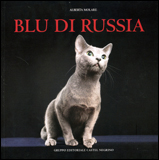Russian Blue
ORIGIN
From Wikipedia, the free encyclopedia
The Russian Blue is a naturally occurring breed that originated in the port of Arkhangelsk, Russia. They are also sometimes called Archangel Blues. It is believed that the first Russian Blues were brought from the Archangel Isles to England and Northern Europe in the 1860s by sailors. The first recorded showing of the breed was in 1875 at the Crystal Palace in England as the Archangel Cat. The Russian Blue competed in a class including all other blue cats, until 1912, when it was given its own class.
The breed was developed mainly in Russia and Scandinavia until after World War II. During and following World War II, due to a lack of numbers of Russian Blues, some people started cross breeding it with the Siamese. Although the breed was in America before the war, it was not until after World War II that American Breeders created what is known as the modern Russian Blue that is seen in the US today. This was done by combining the bloodlines of both the Scandinavian and English Russian Blues. The Siamese traits have now been largely bred out.
Although they have been used on a limited basis to create other breeds (such as the Havana Brown) or add type to a breed in creation (the Nebelung), Russian Blues themselves are short-haired, blue-grey cats.
During the early 1970s, a solid white Russian Blue (called the Russian White) was created by the Australian breeder, Mavis Jones, through the crossing of a Russian Blue with a domestic white cat. By the late 1970s, the Russian White and Russian Black colors were accepted by cat fanciers in Australia as Russian cats (in different classes). However, in North America, the Cat Fanciers Association, does not recognize either variations of the Russian Blue; only The International Cat Association recognizes the Russian Whites and Russian Blacks and only in the provisional classes.
BEHAVIORAL CHARACTERISTICS
The Russian Blue is known for being a very intelligent and tranquil animal. They have been known to play fetch, and are sensitive to basic human emotions. They enjoy playing with a variety of toys and develop extremely loyal bonds to their loved ones. The Russian Blue is also known for getting along very well with other pets and children in a household. They are known also for being quiet and clean animals that are normally reserved around strangers, unless they are brought up in a very active household.
To go a little knowledge of this wonderful breed recommend reading the book:

BLU DI RUSSIA
Edit by: Gruppo Editoriale Castel Negrino
Author: Alberta Molare
It was for us and also enjoy reading,
source of many ideas and notions
about the history of this breed is still uncommon.
PHYSICAL CHARACTERISTICS
The Russian Blue has a lean elongated body and a short, plush, blue-grey coat. The color is a bluish-grey that is the dilute expression of the black gene. However as dilute genes are recessive ("b") and each parent will have a set of 2 recessive genes ("bb") two Russian Blues will always produce a blue cat. The coat is known as a "double coat," with the undercoat being soft, downy, and equal in length to the guard hairs, which are an even blue with silver tips. Only Russian Blues and the French Chartreux have this type of coat, which is described as thick and wonderfully soft to the touch. The silver tips give the coat a shimmering appearance. Its eyes are almost always a dark and vivid green. Any white patches of fur or yellow eyes in adulthood are seen as faults in show cats.
Russian Blues should not be confused with British Blues (which are not a distinct breed but rather a British Shorthair with a blue coat. The British Shorthair breed itself comes in a wide variety of colors an patterns.), nor the Chartreux or Korat which are two other naturally occurring breeds of blue cats, although they have similar traits.
The Russian Blue produces less glycoprotein Fel d 1 and is much less of an allergen source than other breeds of cat. This would suggest that the Russian Blue breed may be hypoallergenic, yet others point out that no cat is truly free of allergens
